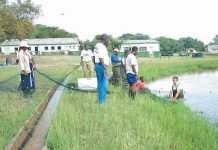[ad_1]
Fishers, observers and inspectors have learned how to “ID” sharks and rays thanks to the SmartFish “Sharks and Rays Initiative”. The initiative aims to: raise awareness about preserving the islands’ biodiversity; enable compliance with new international measures (e.g. CITES); and address global pressure on shark and ray conservation. International fora and instruments are increasingly highlighting the need to obtain information on species caught or affected by fisheries, either as target, bycatch or incidental catch.
The initiative has produced the “On Board Guide for the Identification of Pelagic Sharks and Rays (Western Indian Ocean)” – a handy tool for a wide range of users from both the public and private sectors. The guide is intended to help fishery workers to ID at sea the sharks and rays they encounter.
The initiative has also held two training workshops, one in Mauritius (28–30 October 2014) and the other in Seychelles (4–6 November 2014), to train professionals on how to use the guide and what to look for when trying to ID pelagic sharks and rays. At the end of the course, participants were expected to be able to: use the identification keys to ID pelagic sharks and rays; collect samples and biological data on the species; and be aware of CITES and IOTC measures. A similar workshop is planned for Madagascar and the Comoros in 2015.
FAO has long worked to improve shark management and conservation (e.g. the 1999 International Plan of Action for the Conservation and Management of Sharks). Today, 18 of the world’s 26 main shark-fishing nations have a national plan of action (NPOA) on sharks and 5 more are developing theirs. Seychelles is reviewing its NPOA, and Mauritius is developing one.
[ad_2]
Source link




